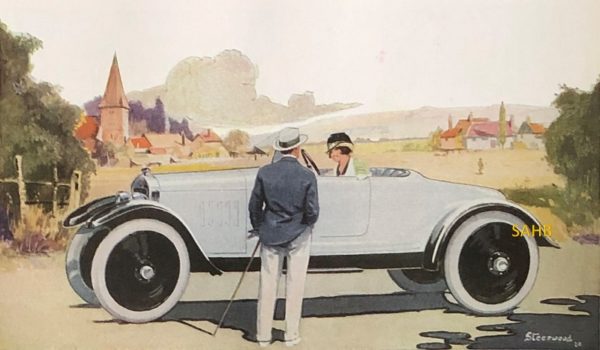
In 1912 John Bernard Taunton designed his first vehicle – a cyclecar with an 8hp 4-cylinder monobloc engine. Very soon after, he introduced something far more ambitious: an underslung car powered by a 4-cylinder 2358cc 14.4hp engine with overhead inlet and side exhaust valves.
The underslung frame (in other words, hanging below the springs and axles) included the cross members, sump, and the lower halves of both crankcase and gearbox in a single stamping – effectively a metal punt or tub. The 3-speed gearbox was therefore mounted low down and drove the rear axle through an underslung worm drive.
Taunton’s company was not short of influential backers: the chairman was the bank-note maker Sir Evelyn de la Rue, and shareholders included the Marquess of Anglesey, the Earl of Lytton, the Duke of Rutland and his daughter Lady Diana Manners, later to become the actress and socialite Lady Diana Cooper.
The original cyclecar and four prototypes of the larger machine were made in a small workshop in Twickenham, but in 1913 Arrol-Johnston vacated their 4.5-acre well-equipped factory in Paisley and moved to a purpose-built factory at Heathhall, just outside Dumfries.
(In a small digression from our story, that new Arrol-Johnston factory was designed by Albert Kahn, architect of the Ford factory at Highland Park, Michigan, and built by an American firm. It was said to be the first factory in Britain to use ferro-concrete.)
Taunton therefore planned to go into production of his car at the Paisley factory. This fell through, and Taunton looked over the Channel to Europe, and settled upon a factory at Bressoux, near Liège, formerly occupied by Hermès cars, well equipped with machine tools and with a capacity of around 1500 cars per year. Sadly, the German army invaded Belgium in 1914 and took over the factory after only two Taunton cars had been built.
History does not relate whether Taunton recovered his factory after the war, but he did promote his car as late as 1921, as proved by our Snapshot, taken from an advertisement in the July 1921 issue of The Motor-Owner and illustrated by Frederick Thomas Steerwood, one of most prolific motoring artists of the 1920s. The only clue to possible post-war manufacture abroad was the name of the company in that post-war advertisement: The International Taunton Engineering Company Limited. But the address was in Westminster, S.W.1.
The post-war cars were thought to be 1914 vehicles updated with disc wheels and more modern bodies – but what type and what engine? The 11.9hp designation is neither from the original 8hp nor from the underslung 14.4hp – and the illustration shows a different radiator from that in a 1914 advertisement and, perhaps more importantly, has none of the look of an underslung car – especially lacking the low frame curving up to the front number plate, so clearly visible in the 1914 illustration. We would be delighted to hear more from anyone who can enlighten us on the final history of these cars.
Photo courtesy of The Richard Roberts Archive.







Jack Taunton was my great uncle. One of the two prototype cars was run by his GP brother in London until removed by dustmen as scrap. Before it was towed away he removed the radiator cap Taunton greyhound badge, now in my ownership. The family view is that if Jack had found a UK production plant, this innovative design would have ensured success in the British motor industry given its clear edge over the competition. Taunton was unusual in that he was both a brilliant engineer and an effective businessman.